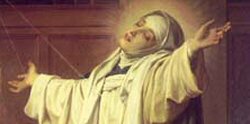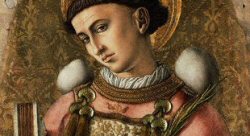 From the Chicago Tribune
From the Chicago TribuneBy KEN KUSMER/Associated Press Writer
INDIANAPOLIS - After resisting the idea for more than three decades, the Roman Catholic Archdiocese of Indianapolis has ordained its first class of deacons, taking some pressure off overworked priests and giving a new role to men who keep one foot in the church and the other in the outside world.
"Everyone kept urging me: 'You've got the makings, you've got the spirituality,"' said Donald Dearman, 57, a Catholic convert and retired correctional officer who was among 25 deacons ordained by the archdiocese last month. "Someone told me they saw the Holy Spirit on the back of my head."
Indianapolis, like most U.S. Catholic dioceses, struggles to recruit enough priests to man its 151 parishes, spread across most of the southern half of Indiana. The number of diocesan priests fell 5 percent from 156 in 2001 to 148 last year. The archdiocese ordained only two new priests this year. Nationally, the number of priests has fallen 13 percent from 45,699 in 2000 to 40,580 in 2008.
At the same time, the number of Catholic deacons in the U.S. has grown steadily, from 898 in 1975 to 16,527 currently, including 13,647 who remain active, according to the Center for Applied Research in the Apostolate at Georgetown University.
When Indianapolis first sought deacon candidates five years ago, it was overwhelmed with the response and had to turn away dozens of men interested in going through the four-year process.
Deacons can't fill the priest void completely; they cannot say Mass, consecrate the Eucharist or hear confessions. But they perform other duties that often fall to priests, including performing baptisms, presiding at marriages as long as they're not Masses, leading prayer services and conducting wakes and funeral services. During Mass, deacons can read the Gospel and deliver the homily, or sermon. Many deacons have careers that put them in the workaday world. The first Indianapolis class included a marketing professor, engineers, an insurance agent and a truck driver.
"With the shortage of priests, it's extremely important," said Joe James, among a handful of permanent deacons who were ordained elsewhere and moved into the Indianapolis archdiocese.
The 70-year-old retired psychologist said that very soon, the three parishes he serves in Richmond, Ind., will be sharing one priest.
Indianapolis' new deacons are members of what Catholics call the permanent diaconate. Candidates for the priesthood become deacons in a transitional step, while permanent deacons remain in that role for life.
Unlike priests and bishops, deacons can be married -- but only if they're married at the time they're ordained. Single deacons generally cannot take wives. Women are not allowed to become deacons.
All but a handful of the nation's 195 dioceses began using permanent deacons in the decades after the office was restored during the Second Vatican Council of the 1960s, said Bill Ditewig of St. Leo University in Florida, former director of deacons for the U.S. Conference of Catholic Bishops.
Yet priests in Indianapolis resisted for a number of reasons, said the Rev. Donald Schmidlin, an archdiocesan priest for 50 years. Some didn't want another holy order that wasn't open to women, and others did not want to further emphasize the clergy over the roles of lay women and men who handle much of the ministry in a parish. Some felt the deacon option would erode the number of men wanting to become priests.
The occasional story from other dioceses about a deacon being poorly prepared or ill-suited for ministry provided further disincentives, Schmidlin said.
"We've benefited tremendously from the successes and failures of other dioceses," Schmidlin said.
To head off one potential area of conflict, the archdiocese developed a training program for deacons that also touched on working collaboratively with lay people on church staffs, said the Rev. Bede Cisco, diaconate director for the 230,000-member Indianapolis archdiocese.
"We've been very careful to tell our guys they are the new people serving in the parish and that they certainly need to respect and work well with those who already are serving," Cisco said.
After the archdiocese decided to accept deacon candidates, informational meetings drew 100 men, and the archdiocese received 52 applications for the first class of candidates in 2004, Cisco said. More than half were turned away for a variety of factors, including age and suitability for ministry.
Hat tip to Deacon Kandra.
























No comments:
Post a Comment